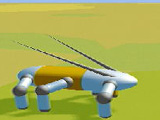
The transformation from high level task specification to low level motion control is a fundamental issue in sensorimotor control in animals and robots. This thesis develops a control scheme called virtual model control which addresses this issue.
Virtual model control is a motion control language which uses simulations of imagined mechanical components to create forces, which are applied through joint torques, thereby creating the illusion that the components are connected to the robot. Due to the intuitive nature of this technique, designing a virtual model controller requires the same skills as designing the mechanism itself. A high level control system can be cascaded with the low level virtual model controller to modulate the parameters of the virtual mechanisms. Discrete commands from the high level controller would then result in fluid motion.
An extension of Gardner's Partitioned Actuator Set Control method is developed. This method allows for the specification of constraints on the generalized forces which each serial path of a parallel mechanism can apply.
Virtual model control has been applied to a bipedal walking robot. A simple algorithm utilizing a simple set of virtual components has successfully compelled the robot to walk eight consecutive steps.
Pratt, Jerry Virtual Model Control of a Biped Walking Robot , M.Eng. Thesis, Department of Electrical Engineering and Computer Science, Massachusetts Institute of Technology, Cambridge, Massachusetts, 1995.
Robots are typically designed with an individual actuator at each joint. This can result in a non-intuitive and difficult control problem. In this paper we present a control method in which the real joint actuators are used to mimic virtual actuators which can be more intuitive and hence make the control problem more straightforward.
Our virtual actuator control method requires a solution to the force distribution problem when applied to parallel mechanisms. An extension of Gardner's Partitioned Actuator Set Control method is presented. This extended method allows for dealing with constrained degrees of freedom in which the torque cannot be specified but can be measured.
A simulated hexapod robot was developed to test the proposed control method. The virtual actuators allowed text-book control solutions to be used in controlling this highly non-linear, parallel mechanism. Using a simple linear control law, the robot walked while simultaneously balancing a pendulum and tracking an object.
J. Pratt, A. Torres, P. Dilworth, and G.Pratt Virtual Actuator Control. IEEE Intrenational Conference on Intelligent Robots and Systems, 1996. Presented November 1996.
Since robots are typically designed with an individual actuator at each joint, the control of these systems is often difficult and non-intuitive. This thesis explains a more intuitive control scheme called Virtual Model Control. This thesis also demonstrates the simplicity and ease of this control method by using it to control a simulated walking hexapod.
Virtual Model Control uses imagined mechanical components to create virtual forces, which are applied through the joint torques of real actuators. This method produces a straightforward means of controlling joint torques to produce a desired robot behavior. Due to the intuitive nature of this control scheme, the design of a virtual model controller is similar to the design of a controller with basic mechanical components. The ease of this control scheme facilitates the use of a high level control system which can be used above the low level virtual model controllers to modulate the parameters of the imaginary mechanical components.
In order to apply Virtual Model Control to parallel mechanisms, a solution to the force distribution problem is required. This thesis uses an extension of Gardner`s Partitioned Force Control method which allows for the specification of constrained degrees of freedom.
This virtual model control technique was applied to a simulated hexapod robot. Although the hexapod is a highly non-linear, parallel mechanism, the virtual models allowed text-book control solutions to be used while the robot was walking. Using a simple linear control law, the robot walked while simultaneously balancing a pendulum and tracking an object.
Torres, Ann L. Virtual Model Control of a Hexapod Walking Robot , S.B. Thesis, Department of Mechanical Engineering, Massachusetts Institute of Technology, Cambridge, Massachusetts, June 1996.
© Copyright MIT Leg Laboratory. All Rights Reserved.